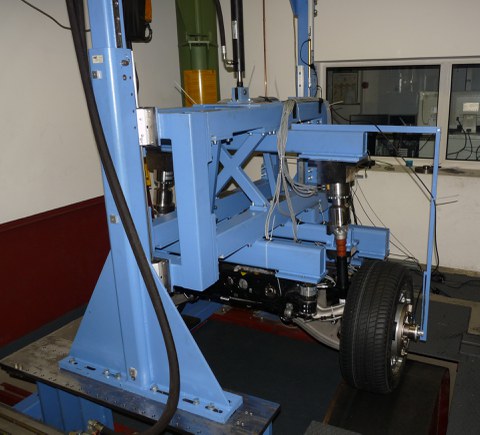Wheel-Axle Test Rig
Table of contents
Functional Description
The Wheel-Axle Test Rig serves to investigate the interactions that arise in the system combination of wheel / tire and chassis. For this purpose, the wheel is driven by a drum and the chassis is attached to its body-side attachment points. The focus of the investigations is on ride comfort and driving dynamics, wherein characteristic parameters of the respective vehicle disciplines can be determined by various maneuvers in conjunction with different drum surfaces.
Fields of Study
Driving Comfort
Determination of the transmission behavior at:
- Harmonic excitation
- Cleat transit
- Stochastic excitation
Vehicle Dynamics
- Steering behavior, transient tire behavior
- Tire behavior at extreme maneuvres
- Analysis of the influence of the axle on the tire behavior
- Determination of driving dynamics parameters
- Steady state circle drive
- Step steer
- Steering angle ramp
- ISO-lane change
- And more...
Key-Facts
- Regulation of wheel load up to 12 kN and steering wheel angle up to 200°, at max. 900°/s steering wheel angle gradient
- Max. 250 km/h
- Measured values:
- Tireforces longitudinal, lateral, vertical
- Self aligning torque
- Longitudinal speed
- Steering wheel angle
- Vertical movement oft he wheel center
- Forces at all attachment points of the axle at the chassis
- Optional: measurement tie rod
- Optional: Measurement of characteristic accelerations on freely oscillatable components
Downloads
Planned Extensions
Planned Extensions
Concept
- Adaptation of the test bench for fast integration of complete axes
- Movement of the test bench frame as structural replacement by means of a hexapod for the representation of the vehicle movement
-
Actuation of the opposite wheel side by means of a 6-axle wheel actuation system
-
Extension of the drum drive performance for longitudinal slip investigations
Goal
The goal is the realistic representation of driving maneuvers in driving comfort and driving dynamics and durability by reducing the movement of the individual vehicle systems to the wheel contact point of a vehicle side. The movement of the vehicle body is made possible by a hexapod and the movement of the opposite wheel by a wheel actuation system. In addition, the use of a powerful drum drive allows the investigation of maneuvers with longitudinal slippage. The test bench concept presented in its entirety thus enables completely new examination possibilities under a realistic representation of maneuver conditions, as current test stand concepts can not yet represent.
Additional examination possibilities
- Testing of the reaction from the vehicle body to characteristic parameters
- Testing of the reaction from the opposite Wheel to characteristic parameters
- Investigation of longitudinal slip maneuvers, when driving and braking the wheel on the drum
